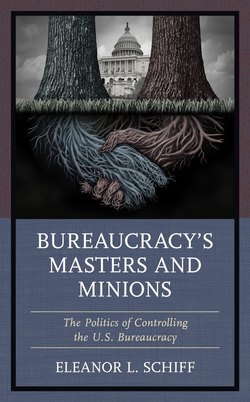Bureaucracy’s Masters and Minions

Реклама. ООО «ЛитРес», ИНН: 7719571260.
Оглавление
Eleanor L. Schiff. Bureaucracy’s Masters and Minions
Отрывок из книги
Bureaucracy’s Masters
and Minions
.....
These hypotheses are evaluated in chapters 5 and 6 which are empirical studies of the theoretical propositions developed in the previous chapters and they also assess the agent-principal model discussed in chapter 4. Specifically, chapter 5 provides a broad test for the agent-principal model and works to overcome all three problems afflicting the bureaucratic control literature: the problem of uniform sampling, the problem of using case studies to make generalizations, and the problem of an overreliance on the principal-agent framework. This chapter utilizes a unique data set of 1,921 observations across 139 different bureaus in the U.S. federal bureaucracy from 2000 to 2014. They range from smaller bureaus with limited budgets such as the American Battle Monuments Commission to larger bureaus with more expansive budgets and workforce complements such as the Employment and Training Administration within the Department of Labor. Utilizing a time-series cross-sectional approach for the pooled panel data, the analysis spans a fifteen-year period. The main findings are that both the president and the Congress control the bureaucracy, but through different mechanisms. Second, internal characteristics of the bureaus affect how political principals control bureaus. This suggests that the nature of control operates differently across institutional settings and that internal agency characteristics condition how principals interact with bureaus. There is substantial support for the agent-principal model developed in chapter 4 which implies that further areas of inquiry into the bureaucracy’s environment are warranted beyond those few scholars who have examined agencies’ organizational elements as a means to explain political control (see Bolton et al. 2015; Kennedy 2014; Selin 2015; Lowande 2019).
Next, chapter 6 takes a more traditional approach in its research design in using a case-study methodology on the dynamics of education policy change in the United States over a sixty-five-year period. This is a more typical format (case studies) for studying a bureau in taking a deep look into a specific area and then teasing out more general trends as they apply more broadly to the bureaucracy. Chapter 6 asks a similar question to the rest of the book: Which political actor is driving [educational] policy change in the United States? Do the internal characteristics of the Department of Education condition how the principals interact with the department? Also using a cross-sectional time-series methodological analysis, the main findings from this chapter are that education policy is elite-driven but that internal characteristics of the department, specifically variation in workforce responsibilities, workforce composition, and workforce organization, can influence the direction of public policy, but it varies by party. This case study also finds support for the agent-principal model developed in chapter 3.
.....